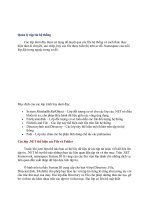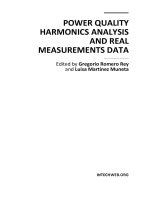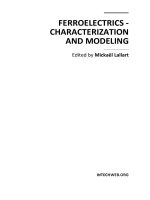Turning and Chip-breaking Technology Part 1 pdf
Bạn đang xem bản rút gọn của tài liệu. Xem và tải ngay bản đầy đủ của tài liệu tại đây (461.88 KB, 10 trang )
2
Turning and Chip-breaking
Technology
‘Machines are the produce of the mind of Man;
and their existence distinguishes the
civilized man from the savage.’
(1762–1835)
[Letter to the Luddites of Nottingham]
2.1 Cutting Tool Technology
In the following sections a review of a range of Turn-
ing-related technologies and the importance of chip-
breaking technology will be discussed.
.. Turning – Basic Operations
Turning can be broken-down into a number of basic
cutting operations and in eect, there are basically
four such operations, these are:
1. Longitudinal turning (Fig. 16a),
2. Facing (Fig. 16b),
3. Taper turning – not shown,
4. Proling – not shown.
NB
ese turning operations will now be very
briey reviewed.
In its most simple form, turning generates cylindrical
forms using a single-point tool (Fig. 1.16a). Here, a tool
is fed along the Z-axis slideway of the lathe (CNC), or
a turning centre, while the headstock rotates the work-
piece (i.e. the part is held in either: a chuck, on a man-
drel, face-plate, or between centres – when overhang
is too long), machining the component and thereby
generating a circular and cylindrical form of consistent
diameter to the turned part
1
. Facing is another basic
machining operation that is undertaken (Fig. 16b) and
in this case, the tool is fed across the X-axis slideway
while the part rotates, again, generating a at face to
the part, or a sharp corner at a shoulder, alternatively it
can be cutting the partial, or nished part to length (i.e
facing-o)
2
. Taper turning can be utilised to produce
short, or long tapers having either a fast taper (i.e. with
a large included angle), or slow taper (i.e. having a
small included angle – oen a ‘self-holding taper’ , such
as a Morse taper). ere are many dierent operations
that can be achieved on a CNC lathe/turning centre,
1 e range of turning operations is vast, feedrates can be var-
ied, as can rotational speeds.
2 Facing operations can also be used to produce either curved
convex, or concave surface features to the machined part –
here the surface is both generated and formed, requiring si-
multaneous programmed feeding motions to the Z- and X-
axes.
including: forming
3
, while others such as drilling, bor-
ing, screw-cutting, of internal features, and forming
and screw-cutting of external features, to name just a
few of the traditional operations undertaken.
With the advent of mill/turn centres, by hav-
ing CNC control of the headstock and rotational, or
‘driven-/live-tooling’ to the machine’s turret, this al-
lows prismatic features to be produced (i.e. ats, slots,
splines, keyways, etc.), as well as drilled and tapped
holes across and at angles to the major axis of the work-
piece, or o-axis. Even this explanation of mill/turn
centres is far from complete, with regard to today’s
sophisticated machine tools. As machine tool builders
today, can oer a vast array of machine congurations,
including: co-axial spindles (ie twin synchronised in-
line headstocks), tted with twin turrets with X- and
Y-axes simultaneous, but separate control, having pro-
grammable steadies (i.e. for supporting long slender
workpieces), plus part-catchers , or overhead gantries
for either component load/unload capacity, to multi-
axes robots feeding the machine tool. is type of ma-
chine tool exists and has multi-axes CNC controllers
to enable the machine’s down-time to be drastically
reduced and in this manner achieving high productive
output virtually continuously.
.. Turning – Rake and Clearance
Angles on Single-point Tools
In order for a turning tool to eectively cut and pro-
duce satisfactory chips, it must have both a rake and
clearance angle to the tool point (Fig. 17). Today’s sin-
gle-point cutting tools and inserts are based upon de-
cades of: past experience, research and development,
looking into all aspects of the tool’s micro-geometry
at the cutting edge. Other important aspects are an ef-
cient chip-breaking technology, in certain instances
critical control of the exure (i.e. elastic behaviour) of
the actual tool insert/toolholder combination for the
latest multi-functional tooling is essential – more will
be said on some of these topics later in the chapter.
e rake angle is the inclination of the top face of
the cutting edge and can vary according to the work-
3 Forming can be achieved in a number of ways, ranging from
complex free-form features (externally/internally) on the ma-
chined part, to simply plunging a form tool to the required
depth.
Chapter
Figure 16. Typical turning operations with the workpiece orientation shown in relation to the cutting insert, for either: (a) cylin-
drical turning, (b) facing. [Source: Boothroyd 1975]
.
Turning and Chip-breaking Technology
piece material being machined. In general, for ductile
materials, the rake inclination is a positive angle, as
the shearing characteristics of these materials tends
to be low, so a weaker wedge angle (i.e. the angle be-
tween the top face and the clearance angle) will suce.
For less ductile, or brittle workpiece materials, the top
rake inclination will tend toward neutral geometry,
whereas for high-strength materials the inclination
will be negative (see Fig. 17), thereby increasing the
wedge angle and creating a stronger cutting edge. is
stronger cutting edge has the disadvantage of requir-
ing greater power consumption and needing a robust
tool-workpiece set-up. Machining high-strength mate-
rials requires considerable power to separate the chip
from the workpiece, with a direct relationship existing
between the power required for the cutting operation
and the cutting forces involved. Cutting forces can
be calculated theoretically, or measured with a dyna-
mometer – more will be said on this subject later in
the text. Both side and front clearances are provided
to the cutting edge, to ensure that it does not rub on
the workpiece surface (see Fig. 17). If the tool’s clear-
ance is too large it will weaken the wedge angle of the
tool, whereas if too small, it will tend to rub on the
machined surface. Most tools, or inserts have a nose
radius incorporated between the major and minor cut-
ting edges to create strength here, while reducing the
height of machined cusps
4
, with some inserts having a
‘wiper’ designed-in to improve the machined surface
nish still further – more will be mentioned on these
insert integrated features later.
.. Cutting Insert Edge Preparations
Oen, a minute edge preparation (see Figs. 17 and
18b, c and d) is created onto the sharp cutting edge of
the insert, this imparts additional strength to the out-
ermost corners of the cutting edge, where the rake and
clearance faces coincide. ere are four basic manners
in which the honed edge preparation is fashioned,
these are:
4 Machined cusps result from a combination of the feedrate and
the nosed radius of the tool. If a large feedrate occurs with a
small nose radius then the resultant cusp height will be high
and well-dened, conversely, if a small feedrate is utilised in
conjunction with a large nose radius, then cusp height is mini-
mised, hence the surface texture is improved.
1. Chamfer – which simply breaks the corner – not
illustrated,
2. Land
– stretching back negatively from the clear-
ance side to various lengths on the rake face (see
Fig. 18b),
3. Radius – around the actual corner (see Fig. 18c)
5
,
4. Parabolic – has unequal levels of honing on two
faces (see Fig. 18d).
Even here, more oen than not, certain combinations
of these four edge preparations are utilised, so that the
cutting forces are redirected onto the body of the rake’s
face, rather than directed down against the more frag-
ile cross-section of the edge. e T-lands and hones
are oen actually incorporated into the insert geom-
etry of the contoured surface. Typical T-lands range in
size from 0.07 to 0.50 mm, having angles varying from
5 to 25° o of the rake face (Fig. 18b).
Honing which is the ‘rounding’ of the cutting edge,
can be performed in one of several ways. Probably
the oldest technique for honing, utilises mechanical
means, which employs a vibrating tub lled with an
abrasive media, such as aluminium oxide – to ‘break’
the corner on these inserts. A variation in this de-
sign, uses an identical abrasive, except here the inserts
are held by centrifugal force to the inside of a rotat-
ing tank. While yet another method of honing using
an abrasive media, involves spraying the inserts with
ne abrasive particles – to hone the edges of the in-
serts. Probably the most popular method for obtaining
cutting insert honed edges, uses brushes made from
extruded nylon impregnated with diamond (see Fig.
18a). e inserts to be honed pass by these brushes in
individual carriers and rotate as they all revolve under
the brushes, thereby applying equal hones to all insert
edges. Depending upon the amount of desired honing,
these brushes can be either raised, or lowered, or alter-
natively, the inserts can make multiple passes through
the machine. All of the above honing techniques pro-
duce a hone that is roughly equal on both the ank
and rake faces – what is termed a ‘round hone’ (Fig.
18c). Yet another honing prole termed the parabolic
hone (i.e. sometimes this honed edge is known as:
5 e radius is sometimes termed ‘edge rounding’ (i.e. denoted
by the letters ‘ER’) – oen applied to most edge preparations,
enabling the cutting forces to be directed on to the stronger
part of the insert.
Chapter
Figure 17. Typical turning ‘nishing’ insert/toolholder geometry and the insert’s edge chamfering, in relation to the workpiece.
Turning and Chip-breaking Technology
P-hone, oval, or waterfall), is produced by a machine
with a so, diamond-charged rotating rubber wheel.
erefore, as the abrasive material rubs across the in-
serts, it tends to extend slightly over the inserts sides,
producing a hone of uneven proportions between the
two insert faces (Fig. 18d). As in the case of the T-land
cutting insert edge preparation, the P-hone directs the
cutting forces into the body of the insert.
Honing can be specied in a number of sizes, usu-
ally being determined by the amount of time these
insert spend in the honing device. e original Stan-
dard for honing was established in the United States by
Figure 18. A honing machine (i.e. brush-style) and several types of honing edge preparations. [Courtesy of Ingersoll].
Chapter
the American National Standards Institute (ANSI) in
1981, which included dimensions and expected toler-
ances for these three basic hones. Today, many cutting
tool manufacturers have expanded upon this Stan-
dard, or adopted their own – specifying hone manu-
facturing and identication methods. Hones must be
applied prior to the application of coatings. Inserts
that are destined to receive a CVD coating, must have
a minimum hone to strengthen the edge, in order to
counteract the eects of this high temperature coating
process. Conversely, PVD coatings, can be equally ap-
plied either over fully-honed insert edges, or on an un-
honed cutting edge. In recent years, the cutting tool
manufacturers have an emphasis toward providing
honed edges of greater consistency and repeatability.
.. Tool Forces – Orthogonal
and Oblique
e cutting forces are largely the result of chip separa-
tion, its removal and chip-breaking actions, with the
immense pressure and friction in this process produc-
ing forces acting in various directions. Stresses at the
rake face tend to be mainly compressive in nature, al-
though some shear stress will be present (see Table 2,
by way of illustration of the machining shear stresses
for various materials), this is due to the fact that the
rake is rarely ‘normal’ to the main cutting direction.
is compressive stress tends to be at its greatest clos-
est to the cutting edge, with the area of contact between
the chip and rake face
6
being directly related to the ge-
ometry here, hence the need for tooling manufacturers
to optimise the geometry in this region.
ere are two distinct types of forces present in
machining operations concerning single-point cutting
tools/inserts (see Fig. 19), these are:
1. Orthogonal cutting forces – two forces (ie tangen-
tial and axial – see Fig. 19b),
2. Oblique cutting forces – three forces (i.e. tangen-
tial, axial and radial – see Fig. 19a).
6 As well as the tool/chip interface temperatures being up to
1,000°C, the interface pressures can reach a maximum of
3,000 MPa, these being sterile smooth surfaces makes them
‘ideal’ conditions for the occurrence of ‘pressure-welding’/sei-
zure.
NB Both of these cutting force models are heav-
ily inuenced by the: cutting tool/insert orientation
to workpiece, tool’s direction of cut and its applied
feedrate
7
.
Oblique Cutting Forces
Fig.1.19a, can be seen a model of the three-dimen-
sional cutting force components in an oblique turn-
ing operation, when the principal cutting edge is at an
angle to the main workpiece axis (i.e. Z-axis). ese
component forces can be separated into the:
•
Tangential force (F
T
) – which is greatly inuenced
by the contact and friction between both the work-
piece and tool, as well as the contact conditions
between the chip and the rake face of the cutting
edge. e magnitude of the tangential cutting force
is the greatest of these three component forces and
contributes to the torque, which in turn, inuences
7 Feedrates play a major role in determining the axial force in
single-point cutting operations, in association with the tool’s
orientation to the part being machined.
Table 2. Typical in-cut shear strengths of various materials
Material: Shear yield strength in cutting
(N mm
–2
)
Iron 370
0.13% C. steel 480
Ni-Cr-V steel 690
Austenitic stainless steel 630
Nickel 420
Copper (annealed) 250
Copper (cold-worked) 270
Cartridge brass (70/30) 370
Aluminium (99.9% pure) 97
Magnesium 125
Lead 36
[Source: Trent ( 1984)]
.
Turning and Chip-breaking Technology
Figure 19. The two- and three-force models of orthogonal and oblique cutting actions,
with the component forces approximately scaled to give an indication of their respective
magnitudes
.
Chapter
the power requirement for cutting. Fundamentally,
the product of the tangential force and the cutting
speed represent the power required for machining.
e specic cutting force
8
is a unit expression for
the tangential cutting force, being closely related to
the material’s undeformed chip thickness and se-
lected feedrate,
•
Axial force (F
A
) – the magnitude of this force will
vary depending on the selected feedrate and the
chosen tool geometry and in particular, the ‘plan
approach angle’ , or ‘entering angle’ , – more will
be said on this topic later. Its direction is from the
feeding of the tool, along the direction of workpiece
machining,
•
Radial force (F
R
) – is directed at right angles to the
tangential force from the cutting point. e ‘plan
approach angle’ and the size of the nose radius, will
inuence this force.
NB ese three component forces are signicantly
inuenced by the rake angle, with positive rakes
producing in general, lower cutting forces. e re-
sultant force
, its magnitude and angle, will be af-
fected by all three component forces, in conjunc-
tion with the tool’s geometry and the workpiece
material to be cut.
Or thogonal Cutting Forces
In Fig. 19b the two-dimensional model for orthogonal
cutting is depicted, once again, for comparison to the
oblique cutting model, in a single-point turning op-
eration. For simplicity, if one assumes that the point of
the tool is innitely sharp and that the tool is at right
angles to the workpiece axis having no deection pres-
ent, then the two component forces are the tangential
force and axial force (i.e. previously mentioned above).
In this case, this tool geometry-workpiece congura-
tion, allows long slender bars to be turned, as there is
less likelihood of tool ‘push-o ’ (i.e. as the radial force
8 In reality, the specic cutting force is a better indication of
the power requirement, as it is the force needed to actually
deform the material prior to any chip formation. It will vary
and is inuenced by the: undeformed chip thickness, feedrate,
and yield strength of the workpiece material. For example, if
the cutting conditions are kept the same and only the material
changed, then if a nickel-based alloy is machined, the initial
chip forming force (i.e. specic cutting force) will be more
than ten times greater than when cutting a pure aluminium
workpiece.
has been neutralised – as indicated by the fact that the
resultant force shows no X-axis oset). If any radial
force was present, this would create either a ‘candle-
stick eect’ , or ‘barrelling’ to the overall turned length.
In reality, there will always be some form of nose ra-
dius, or chamfer to the tool point, which will have
some degree of ‘push-o ’ , depending upon the size of
this incorporated nose feature – creating a ‘certain de-
gree’ of radial component force aect.
.. Plan Approach Angles
e manner in which the cutting edge contacts the
workpiece is termed the ‘plan approach angle’ (Fig.
20a), being composed of the entering and lead angles
for the selected tool geometry. In eect for single-
point turning operations, the tool’s orientation of its
plan approach, is the angle between the cutting edge
and feeding direction. When selecting a tool geometry
for turning specic workpiece feature – such as a 90°
shoulder – it is important as it will not only aect the
machined part geometry, but has an inuence on con-
sequent chip formation and the direction and magni-
tude of the component cutting forces, together with
the length of engagement of the cutting edge (see Fig.
20b). In single-point turning (Fig. 20b), the depth of
cut (D
OC
)
9
, or ‘cutting depth’ is the dierence between
an un-cut and cut surface, this being half the dier-
ence in the un-cut and cut diameter (i.e. the diame-
ter is reduced by twice the D
OC
in one pass along the
workpiece). is D
OC
is always measured at 90° to the
tool’s feed direction, not the cutting edge. e manner
in which the cutting edge approaches the workpiece is
termed the ‘entering angle’ (i.e. plan approach angle),
this being the angle between the cutting edge and feed
direction (Fig. 20a – shown here in a cylindrical turn-
ing operation). Moreover, the plan approach angle
not only inuences the workpiece features that can be
produced with this cutting geometry, it also aects the
formation of chips and the magnitude of the compo-
nent forces (Fig. 20b).
e ‘entering angle’ aects the length of the cut-
ting edge engaged in-cut, normally varying from 45°
to 90°, as illustrated in the four cases of diering plan
approach angles shown in Fig. 20b. Here, in ‘case I’ an
9 In single-point turning operations, the depth of cut (D
OC
) is
sometimes referred to by the term: ‘undeformed chip thick-
ness’.
Turning and Chip-breaking Technology
Figure 20. Insert approach angle geometry for turning operations.
Chapter









